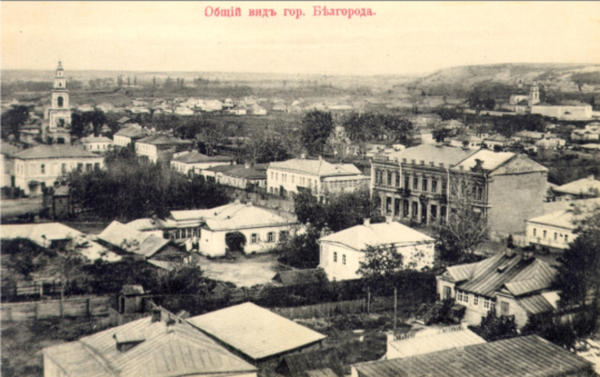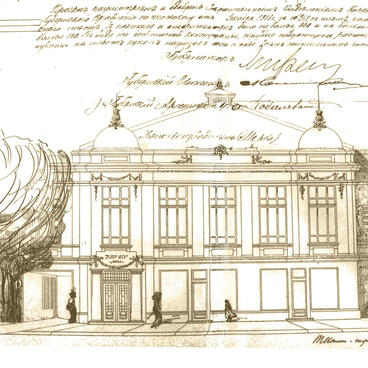The postcard on display, showing a street in the center of Belgorod, gives a glimpse of what the city was like more than a century ago.
Until the beginning of the 20th century, the city’s main street was called Korochanskaya Street. In 1904, Emperor Nicholas II graced the town with a visit and traveled down Korochanskaya Street from the railway station to the Holy Trinity Cathedral. After that, the street was renamed after the monarch.
In 1911, on the occasion of the procession to honor the canonization of Saint Ioasaph, Belgorod was again visited by members of the Imperial family — the Grand Duchess Elizaveta Feodorovna and Grand Duke Konstantin Konstantinovich. Saint Ioasaph (Gorlenko), Bishop of Belgorod and Oboyan, was canonized in 1911 at the petition of the laity and clergy — after the relics of his incorrupt relics had been discovered and after miracles of healing had occurred on his grave. Nicholas II signed the petition saying, “I accept the proposals of the Holy Synod with sincere adoration and deep compassion.”
In the early 20th century, the Street of Emperor Nicholas II was home to many important establishments for the city. Among them were five photo studios, four of the city’s eight pharmacies, and shops: a bookstore, the only music shop and a Singer shop, selling sewing machines. There was also a cultural center with three cinemas: “Orion”, “Illusion” and “Biograph Pâté”.
A branch of the French studio of the Pâté brothers appeared in the Russian Empire in the early 20th century, and in 1907 a cinema named after them opened in Belgorod. They had two cinema halls, two control rooms and their own oil engine. The cinema showed mainly chronicles. Brothers Sergey and Mikhail Nikolsky are considered to be the owners of the cinema.
A branch of the Russo-Asian Bank — the most important among the Russian joint-stock banks in 1910–1917 — was situated in the Street of Emperor Nicholas II. Of note was the building which, apart from shops and hotel rooms, housed the printing house of Alexander Alexandrovich Weinbaum and the pharmacy of Shimon Aaronovich Kogan. Among other things, Weinbaum’s print shop produced postcards, including the original of this exhibit.
The Church of Presentation can be seen in the background on the left. It was a wooden church in 1626 and was replaced by a stone church with a bell tower in 1777. In the middle of the 19th century, it was “renovated”, and in the Soviet time — destroyed. Today, the former Street of Emperor Nicholas II was called Grazhdansky Prospect.
The original postcard was lent to the museum by a Belgorod collector Anatoly Tkachenko to create this exhibit.
Until the beginning of the 20th century, the city’s main street was called Korochanskaya Street. In 1904, Emperor Nicholas II graced the town with a visit and traveled down Korochanskaya Street from the railway station to the Holy Trinity Cathedral. After that, the street was renamed after the monarch.
In 1911, on the occasion of the procession to honor the canonization of Saint Ioasaph, Belgorod was again visited by members of the Imperial family — the Grand Duchess Elizaveta Feodorovna and Grand Duke Konstantin Konstantinovich. Saint Ioasaph (Gorlenko), Bishop of Belgorod and Oboyan, was canonized in 1911 at the petition of the laity and clergy — after the relics of his incorrupt relics had been discovered and after miracles of healing had occurred on his grave. Nicholas II signed the petition saying, “I accept the proposals of the Holy Synod with sincere adoration and deep compassion.”
In the early 20th century, the Street of Emperor Nicholas II was home to many important establishments for the city. Among them were five photo studios, four of the city’s eight pharmacies, and shops: a bookstore, the only music shop and a Singer shop, selling sewing machines. There was also a cultural center with three cinemas: “Orion”, “Illusion” and “Biograph Pâté”.
A branch of the French studio of the Pâté brothers appeared in the Russian Empire in the early 20th century, and in 1907 a cinema named after them opened in Belgorod. They had two cinema halls, two control rooms and their own oil engine. The cinema showed mainly chronicles. Brothers Sergey and Mikhail Nikolsky are considered to be the owners of the cinema.
A branch of the Russo-Asian Bank — the most important among the Russian joint-stock banks in 1910–1917 — was situated in the Street of Emperor Nicholas II. Of note was the building which, apart from shops and hotel rooms, housed the printing house of Alexander Alexandrovich Weinbaum and the pharmacy of Shimon Aaronovich Kogan. Among other things, Weinbaum’s print shop produced postcards, including the original of this exhibit.
The Church of Presentation can be seen in the background on the left. It was a wooden church in 1626 and was replaced by a stone church with a bell tower in 1777. In the middle of the 19th century, it was “renovated”, and in the Soviet time — destroyed. Today, the former Street of Emperor Nicholas II was called Grazhdansky Prospect.
The original postcard was lent to the museum by a Belgorod collector Anatoly Tkachenko to create this exhibit.



